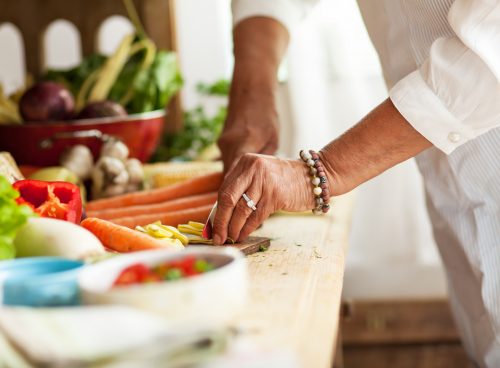
When money’s tight, it pays to look back to learn how others managed through tough times. Niki Bezzant takes a look at what we can learn from our grandparents about shopping, cooking and keeping house – and how we can apply their tried and true strategies to our modern lives to help us spend less and stay healthy.
How to make basic ingredients tasty
Fifty or 60 years ago, Grandma had a very basic range of ingredients to choose from. Things like olive oil, pasta, soy sauce, different cheeses, even garlic were exotic and uncommon. But she knew how to work with what she had, and base her dishes on simple, inexpensive ingredients like mince, smoked fish, eggs and potatoes.
Downside
To do this Grandma also used a fair amount of butter, cream, cheese and lots of fatty meat, all of which (we now know) are not so good for us!
What we can learn
It’s time to rethink our meal bases and take a new look at old favourite ingredients and recipes cooked in healthy ways.
Money-saving tips
- A can of smoked fish: Around $4 for 310g can. Add a white sauce, lots of vegetables and mashed potato, and you have a classic smoked fish pie for less than $6 for 4-6 people.
- Eggs: Between $0.20 and $0.50 each. 4 eggs, some leftover cooked vegetables, and a sliced chorizo sausage ($1) makes a tasty frittata to feed 4 for around $4.
- Lean beef mince: Around $5 for 500g. Add breadcrumbs, rolled oats, herbs, spices and an egg, and make meatballs or a meat loaf to serve with potatoes and a salad for around $10 for 4 (with leftovers).
How to make the most of every bit of food
That meant making what we’d consider one meal’s worth of something last over two or three nights.
Downside
Grandma didn’t have the wide repertoire of recipes, nor the access to the range of meats we have today, so the week’s dinners could get a bit boring!
What we can learn
Clever ways to stretch more pricey ingredients such as meat and cheese to help us keep our budget under control (and make us feel really clever!). We can look at old favourite ingredients and recipes, cooked in healthy ways.
Money-saving tips
- A $9 packet of mince can stretch to two quick meals (and get a health boost) by adding a bit of padding! Brown onion, garlic and carrots. Add mince and brown. Set half the cooked mince aside. Add a can of flavoured tomatoes and chopped or grated vegetables, then simmer to make pasta sauce. The next night, use the other portion of mince and add a can of chilli beans, a can of tomatoes and Mexican spices to make a chilli. Serve with rice and a salad. Or take it in a different direction and make a stir-fry by adding lots of thinly sliced vegetables, soy sauce, chilli sauce and noodles.
- Instead of chicken breasts for one meal, buy a whole chicken on special (we’ve seen them for under $10) and spread it over several meals. Serve chicken roasted with lots of vegetables on the first night. Then use leftover cooked chicken to make a chicken and corn soup the next night: bring stock to the boil, add chilli, soy sauce, ginger, garlic and a can of corn kernels. Add chicken, fresh coriander and mint. Use the remaining chicken carcass to make stock (it’s not as hard as it sounds – see How to cook stock).
How to use cheap cuts of meat
In Grandma’s day, even though meat was abundant, it wasn’t all cheap. Grandma understood how to cook cheaper cuts to make them tender, tasty and delicious.
Downside
Cheaper cuts can be higher in fat, so Grandma’s cooking methods need an update to make them healthier.
What we can learn
If we get to know the cheaper cuts, we can save money on meat and make tasty, hearty dishes that go a long way.
| CUT | COST | HOW TO COOK |
| Beef brisket, thick flank or silverside (unsalted) | $16-$20/kg | Trim fat. Simmer gently in one piece, in water flavoured with onions, carrots, celery and herbs. Cook for 50 minutes per 1kg, plus an extra 25 minutes. Serve sliced with vegetables. |
| Blade steak, chuck steak, gravy beef, stewing steak | $18-$20/kg | Use for stews and casseroles. Remove visible fat. Cut in cubes. Brown in pan, then add vegetables and cover with water, stock, tomatoes or other liquid. Simmer gently, covered, for at least 1 1/2 hours, until tender. |
| Skirt steak | $16/kg | Score, marinate and cook quickly (6-8 minutes only) in a hot pan. Slice across the grain and add to stir-fries, or eat with sauce and a salad. |
| Beef shin | $16/kg | Braise whole in beef stock, wine and herbs. Cook, covered, for 2 or more hours, until tender. Remove from bone and use in casseroles, curries or chilli. |
| Lamb knuckles (shanks) | $16/kg | Gently simmer, covered, in liquid for 2 hours. Serve on the bone, or remove from the bone and add back to sauce. Leave to cool and skim fat from top of stew. |
| Lamb shoulder, thick shank | $17/kg | Use for stews or casseroles. Remove visible fat. Cut in cubes. Brown in pan, then add vegetables and cover with water, stock, tomatoes or other liquid. Cover, and simmer gently, for at least 1 1/2 hours until tender. Serve with vegetables and mashed potato or pasta. |
Recipe ideas
Try these healthy, hearty recipes using cheap cuts of meat:
Beef and lentil casserole
Lamb shank, capsicum and lentil casserole
Lamb ragu for pasta
Beef and thyme casserole
How to make things from scratch
Grandma didn’t have supermarket convenience foods. Actually, there weren’t many supermarkets around when she first started cooking for her family – the first one opened in the late ’50s. This meant if she needed a marinade or a simmer sauce, she made it herself.
Downside
Grandma didn’t have the busy working lifestyle we now have, so she had more time to do all that cooking! However, some things can be made from scratch without taking hours.
What we can learn
Buying fewer pre-made items will significantly cut our food bills.
Money-saving tips
- Basic Asian ingredients: If you have a stock of basic Asian ingredients on hand you can do away with the need for stir-fry sauces and flavour sachets, save money and make tastier meals.
- Canned tomatoes and herbs: A can of tomatoes and some fresh or dried herbs are really all you need to make pasta sauce. Stock up when they’re on special and you’ll never need a jar of ready-made sauce again.
- Do you make Thai or Indian curries often? Making your own fresh curry paste takes no time and it packs more flavour than bought curry paste.
- Biscuits and cakes: Grandma hardly ever bought biscuits or cakes. Treats like these aren’t everyday foods, but if you’re going to spoil yourself and your family, why not give homemade sweet treats a go?
- If you love pasta, think about investing in a pasta machine: They cost about $80, but you’ll make that back quickly. Making a batch of fresh pasta costs less than $1, and once you’ve eaten your own handmade pasta, you’ll never want to buy the packaged variety again.
Recipe ideas
Replace pre-made with homemade! Try these make-your-own versions of stir-fry sauces and dressings:
Pasta sauce
Honey, soy and ginger marinade / stir-fry sauce
Satay sauce
Sweet and sour sauce
Thai curry paste
Balsamic dressing
How to use leftovers
Having grown up in the depression, Grandma hated waste. She knew how to make the most of any leftovers – and some of them were really yummy!
Downside
Some of us remember the awful feeling of déjà vu that descended with the arrival of the mutton roast on the table for the third day in a row! Nowadays, thankfully, we have interesting additions to perk up tired leftovers.
What we can learn
Minimising waste by using up leftovers in creative ways makes us feel good, be green, and helps us spend less.
Money-saving tips
- Leftover pasta or noodles can be made into a yummy frittata: Just as potatoes or other vegetables are used to make a frittata, combine pasta/noodles with eggs in a pan. Add herbs and leftover meat. Serve with tasty relish and a big salad.
- To revive a stale loaf of bread, sprinkle it with water or milk and wrap it in foil. Bake bread at 180ºC for about 8 minutes, or a few minutes longer for French bread. Leave the foil open for the last few minutes.
- Use up hard cheese and stale bread: Whiz together in the blender or processor to make cheesy crumbs. These make a delicious topping for bakes or coating for fish.
- Jazz up leftover cooked potatoes by making modern bubble ‘n’ squeak: Fry onion and garlic in a pan, add leftover sausages or a little bacon, add chopped or mashed potatoes and any other leftover vegetables you have, and fresh spinach or silver beet. Cook until it forms a golden crust on the bottom, then slice into wedges and serve with barbecue or chilli sauce.
- Make leftover rice into rice cakes: Combine with an egg to bind, add fresh basil and parsley or other herbs, and a little grated cheese. Shape into cakes and cook in a moderate pan, or in the oven. Serve with meat or on their own.
How to keep it simple
Grandma lived simply because there was no other way. She wasn’t afraid to cook and serve plain food to her family and friends, and didn’t feel pressure to buy expensive ingredients to impress.
Downside
Grandma didn’t travel much and didn’t eat out often, either, so her palate wasn’t exposed to the wide variety of flavours and cuisines we like to eat today.
What we can learn
Embracing a ‘keep it simple’ mantra while still incorporating tasty modern flavours can offer us the best of both worlds: less stress in the kitchen and significant savings.
Money-saving tips
- Grandma didn’t drink bought soft-drinks: Follow that example and make water the family’s main beverage. You’ll save money ($8 a week or more), and everyone will be healthier.
- Wine didn’t regularly feature on her shopping list: Cut out one bottle a week from your shopping and you will save $10 or more – you may even lose weight!
- Entertain at home more, and don’t be scared to serve simple dishes: Who doesn’t love a beautifully made fish pie, lasagne or Sunday roast? Entertaining doesn’t have to be an expensive, fancy production.
- It’s time to revive the pot luck dinner: Plan it out so you don’t end up with lots of mismatched food. Keep the dishes simple and get everyone to bring something. It takes any preparation pressure off the host(ess) and it’s fun!
- Grandma mostly ate in season: This is a money-saver for us, too. Keep in touch with what’s growing now and base most of your meals on seasonal produce, adapting as you go for what’s available.
www.healthyfood.com










